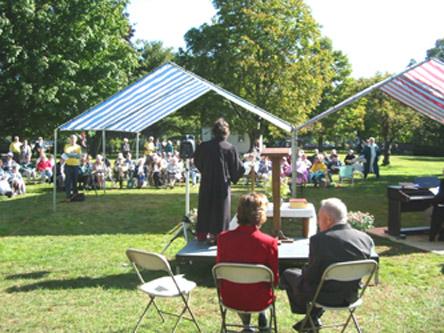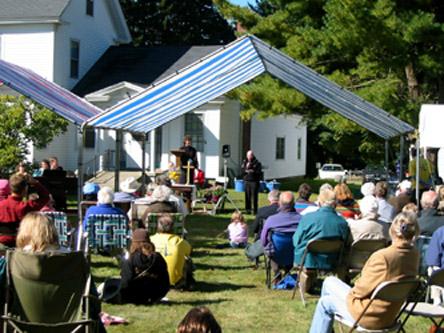By Isabel Grasso
Atlantic News, Thursday, October 9, 2003


They came to worship in the new church that they were so proud of. The weather was still warm, with the foliage just started to give a preview of the beauty that was to come. They came to worship, glorying in the freedom of worship that was now theirs. They seated themselves in the church, the women and young girls on one side of the central aisle, the men and boys on the other. The men were bareheaded out of respect, but the women and older girls wore bonnets. This was the first service, October 14, 1638. Happiness and pride showed in the earnest faces of this small group of Puritans. They had come a long way and accomplished much.
It was only 18 years since this group had landed at Plymouth Rock in Massachusetts, and left the safety of the Mayflower that had brought them across the ocean. The first year was a hard one, in a new land far from home, not being too sure how to take care of themselves in their new environment. Yet they needed food, shelter and clothing. The Native Americans, whom they called Indians, helped. They were not looking to make war with these people who were on their land, but instead, helped the pilgrims grow the crops they needed and live their lives here.
They had kept working their way north, finding many villages with a few people, none of the towns were heavily populated. They rested, looked around and decided to go on. They were looking for fertile land where they could grow crops; perhaps a place on the ocean where they could fish and find other foods, transport themselves and logs. But especially, they sought the salt marshes, where the farm animals could feed on the hay which grew there. They found that Hampton would give them everything they needed and built homes here, getting on with their lives. The James House stands ready to show their ingenuity and industry, and the Tuck Museum as well.
Wars came through the years, machines were invented that made work much easier, the homes became more comfortable to live in, although men and women worked sunup until after the sun had set. They did their work and also taught their children to perform the many tasks needed for survival.
They came to worship in the church, year after year, decade after decade, generation after generation. Their trust was in God, and there was often Bible readings and prayers said at home after the church service on the Sabbath. The children learned to read the Bible and worship God.
Electricity came, and radios. Washing machines made the work of the housewife much easier. Aspirin came, penicillin, bandages, electric toothbrushes, indoor plumbing, even cars. The Model T changed the face of the country and the roads the cars needed later created suburbs, easing urban sprawl.

[Atlantic News Photos by John Hirtle]
They came to worship, long after World War I and World War II with its Iron Curtain, after the Korean Conflict, the war in Vietnam, the influx of refugees from many countries, the "melting pot" going on and on, the many new people with their languages and customs being absorbed into this wonderful young country. Politicians came and went, administrations changed, television, magazines and newspapers kept everyone informed. Submarines came, airplanes, surgery without pain, and plastics.
They came to worship, on October 5, 2003, 365 years after the first church services at the First Congregational Church of Hampton. They came to celebrate this longest continuously operating church. They came to gather at nearby Tuck Field on Park Avenue, to sing hymns and then to have a church service honoring the past, while cherishing the present and looking forward to the coming future, with families and the church members united.
They came to worship—many members of the United Church of Christ, (Congregational) in North Hampton. They had been invited to share in the celebration. Other ministers came—Rev. Michael Mulberry, Rev. Tracy Heilman, and Rev. Henry J. Stonie, all for local churches. But it was the minister of the host church, Rev. Deborah B. Knowlton, who presided over the service and the celebration. The members of the choir were there, with their robes on, and the children's sermon was given by Rev. Debbie, David Morochnick, musical director of the church, led the singers. In some of the numbers, he played a keyboard which had been hooked up. The service followed the usual order. The service was held in back of the Tuck Museum on Park Avenue, and this is the site of the first building which housed the church members. Five meeting houses were built before the present building building at 127 Winnacunnet Road.
In the time period of the 365 years, there have been many ministers. The first one was Stephen Bachiler from 1638-1641. He was followed by 32 other and one interim minister, bringing us to the present minister, Rev. Knowlton who came to the church in 1999. Some of the names were from well known families — the Cotton family, for example. The history of the Church has been meticulously researched and written by historian, Mrs. Elizabeth Aykroyd.
They came to worship and to celebrate this -- mega anniversary of 365 years -- men, women, and children came and babies. Friends greeted one another and it was a very happy and joyous occasion, this union of neighbors and worshipers. A picnic followed, then games for the children and trolley rides in the afternoon. It was a wonderful celebration.
